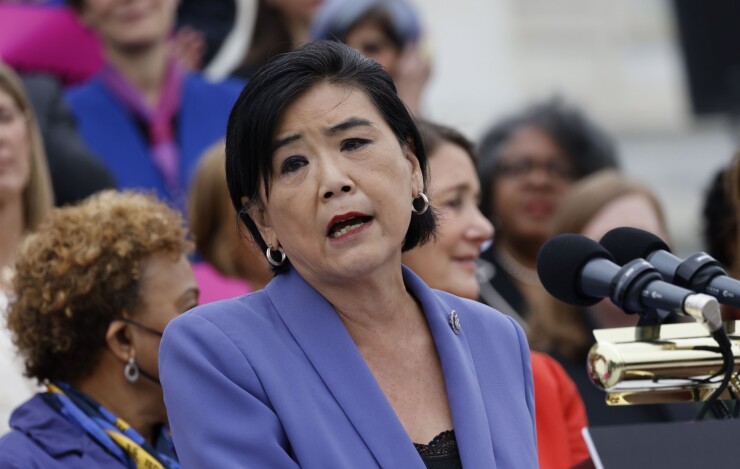
Backers hope the third time is the charm for a bill that would raise the bar for bank investment in Small Business Administration-backed investment funds.
The Investing in Main Street Act would permit banks to invest up to 15% of their capital in SBA-registered small-business investment companies, a substantial increase above the current 5% threshold, a limit that has remained unchanged for more than six decades.
Promoted by seven-term California Democrat Judy Chu, the legislation has passed the House three times in the past five years, each with overwhelming majorities — including a 411-13 vote in January 2023. It has fared less well in the Senate. Sen. Todd Young, R-Ind., introduced a companion to Chu's House version in July 2021, but it never advanced out of the Senate Banking Committee.
Young reintroduced the bill last month, along with co-sponsors Sens. Tammy Duckworth, D-Ill., and Jim Risch, R-Idaho. It is currently pending in the Banking Committee.
"The Small Business Investment Company program has provided critical support to countless Hoosier small businesses," Young said in a press release. "I'm proud to reintroduce this bipartisan legislation to help spur further investment."
By all appearances, the legislation commands broad support among lawmakers in both parties, bankers, the trade group that represents SBICs and the investors themselves. The question is can Young, Duckworth and Risch muster enough support in the Senate to push it across the goal line.
"I'm hoping it can make it through," Chu said Thursday in an interview. "It makes so much sense."
Unlike the SBA's other major programs, 7(a) and 504, both of which support lending, the Small Business Investment Company Program supports equity investments by participating funds, many of whom are owned or backed by banks. Though the Volcker Rule generally restricts banks from proprietary trading or from investing in private equity funds, it made an exception for SBICs. Banking regulations permit banks to invest up to 15% of capital in SBICs. The rub lies in the language of the 65-year-old Small Business Investment Act of 1958, which caps banks' SBIC participation at 5% of capital.
Bank SBIC investments are also presumed to qualify for Community Reinvestment Act credit, so long as the SBIC is located or does business in a bank's assessment area.
"There is this hiccup in terms of banks," Chu said. "The 1958 law has never been updated. This has to be corrected."

Even with the longstanding 5% cap, SBICs remain a popular investment option for banks. Dozens of the 303 existing small-business investment companies are owned by banks, while scores of other funds have benefited from bank backing. Indeed, about 700 banks are invested in SBICs, providing about half the capital in the space, according to Brett Palmer, president of the Washington-based Small Business Investor Alliance, a trade group representing private equity funds focused on small business.
By tripling banks' investment threshold to 15% of capital, the Investing in Main Street Act would significantly boost access to capital for funds seeking cash to invest in small businesses and, ultimately, for small businesses, Palmer said in an interview. "It's a win-win for everybody," he added.
"With this simple legislation, small businesses will have access to capital for growth and advancement, which in turn will create employment opportunities," Faraz Abbasi, managing director at Centerfield Capital, an Indianapolis-based SBIC, said in a press release.
Palmer referred to the bill as a "simple, modest improvement" in a recent letter to the House Small Business Committee. "Nobody thinks [the current 5% of capital limit] is good public policy," Palmer said.
The SBA does not normally comment on pending legislation, a spokeswoman said.
Under the SBIC program, the SBA provides a pool of low-cost capital to participating SBICs, which leverage it with private-sector contributions. In fiscal 2023, which ended Oct. 31, SBICs invested a record $8.1 billion in 1,208 small businesses, according to the SBA. Those totals were up from $7.8 billion invested in 1,217 small businesses in fiscal 2022. The program's lending limit totaled $5 billion in fiscal 2023. The Biden administration sought a $1 billion increase to $6 billion in 2024 and has budgeted a further $1 billion increase in its fiscal 2025 spending plan.
The fiscal 2025 increase "would significantly expand the availability of patient capital and equity investments across the nation," SBA Administrator Isabel Casillas Guzman said in a press release last week.






